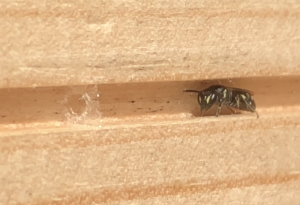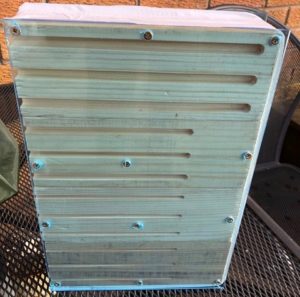This is not a bee hotel! It is a solitary bee nest box with observation windows! As seen recently on Springwatch 2018
In the film you will see, besides 11 different solitary bee species, including a Coelioxys cuckoo bee and not often seen or filmed, its larva with egg crushing or larva killing mandibles. I watched this cuckoo bee and when it went inside the nest cavity, marked on the observation glass where exactly the cell was that it had laid its egg inside. Later I found it and opened the cell to see and film the cuckoo larva. You’re probably very unlikely to see this in your bee hotel!

Female Hylaeus sp. Yellow-Faced bee with just one of the several portals she made.
These wild spring and summer bees will live inside their nest site from egg to larva to cocoon and adult. This could probably take 9-10 months, depending on species, temperatures, etc. Besides viewing the different bees you will also be able to view, the different nesting materials, pests and other residents that use the nest box. It really does open up another window into nature!
I wanted to widen the diversity of species using the observation nest box, to include smaller bees and even harmless solitary wasps. After several years of trying out various designs, I am pleased to say I have achieved this. The new summer units have proved extremely successful having greatly increased the bees and harmless solitary wasps species that you can see as they make their nests or rest inside the nest box.

Nest blocks may be different than those shown above
With thanks to:
Kate Bradbury for the hairy-footed flower bee photo, Prof. Phil Stevenson for his yellow-faced bee and M. versicolor film and Dr Hauke Kock for his Heriades truncorum photos. The list grows!
“All my articles and videos, available free, are funded by my teaching, presentations and sales of award-winning bumblebee nest boxes, solitary bee boxes with accessories. Please help by spreading the word and forwarding this link to your friends and colleagues. https://nurturing-nature.co.uk Thank you” George Pilkington MSc. Cert. Ed
All filmed using a Nurturing Nature Solitary bee observation nest box for our wild bees and solitary wasps
I hope the ID of the bees is correct, I did use the book below and the BWARS site!!
For info and link to buy an excellent book Field Guide to the Bees of Great Britain and Ireland by Steven Falk
An extremely useful resource supports this book with a special website feature within Steve Falk’s Flickr website which furnishes extra photos and other useful resources to assist with identification.
IInterested in Citizen Science and pollinators? (e.g. bees!) The Buzz Club

Recent Comments